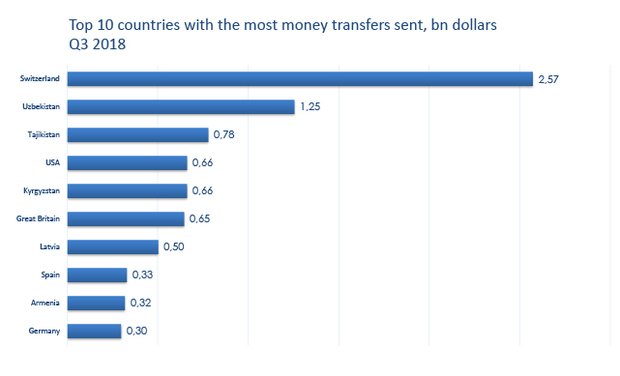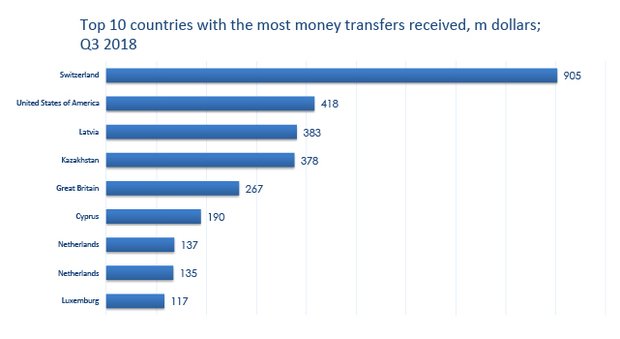Transfer issues. 'Golden' thousand of transactions to Monaco and billions to Switzerland
How natural persons transferred $12bn from Russia, but only $7bn got back. Tatarstan is leader in transactions abroad
As Realnoe Vremya's analytic staff found out, Switzerland remains the main destination of money transfers from the territory of Russia: natural persons transferred $6,3bn in 9 months, and only a half of this sum is back. The general negative balance of transfers abroad reached $18,6bn in January-September. Realnoe Vremya tells how the geography of transfers sent and received.
Margin increases
Natural persons transferred to Russia $7,3bn less in the third quarter than they did abroad; the negative balance of transfers have totalled $18,6bn since the beginning of the year and exceeded last year's January-September result by 9%. The year-on-year sum of transfers to Russia decreased by $91m, while the volume of outgoing transfers rose by $681m.
$34,6bn in total were sent from Russia in 9 months (of which almost 12,3bn were in July-September). According to the Central Bank's data, Switzerland remains the main destination of the transfers sent: almost $2,6bn went there in the third quarter, which is over 20% of the total sum of the money sent from the territory of Russia.
Uzbekistan, Tajikistan, the USA and Kyrgyzstan are also in the top 5 countries with the most money transfers sent: these five states accounted for almost a half (48%) of all money transfers from Russia.
The geography of outgoing transfers changed during the year, but not significantly. China left the top 5 destinations. It went down from the fifth place in July-September last year to the 14 th place in the third quarter of 2018; the sum of transfers to China reduced 2,8 times. The USA, which is in the top 5 with transfers this time, was just seventh last year.
According to Timur Nigmatullin, analyst at Otkritie-Broker, the reduction of transfers to China might be explained by several factors: the next tightening migration legislation, a weaker ruble rate (as currency revaluation influences the statistics) and a fall in the labour market. ''I don't exclude the collapse in the cryptocurrency market also affected transfers to the PRC – factories making corresponding equipment and mining capacities are located in the PRC,'' he adds.
The biggest volume of transfers from the territory of Russia was classified as ''personal money transfer'' ($4,4bn were sent abroad for this reason). Another $1,1bn were ''non-repayable transfers''.

In case of received money transfers, the list of the key partner countries looks different. However, Switzerland became a leader here as well: $905m came from the territory of this country to Russia in July-September.
The USA, Latvia, Kazakhstan and Great Britain are ranked second-fifth with the volume of transfers. The top 5 countries account for 47% of the overall sum of received cross-border transfers (about $2,4bn).
The geography of ''donor countries'' also changed just slightly. Cyprus left the list of the five biggest money senders (it fell from the fifth to the seventh place), while Great Britain occupied its seat, which was on the sixth line one year ago.
The total volume of cross-border transfers to Russia in the third quarter amounted to a bit less than $5bn, over $16bn this January-September.

Help for southern coast
The average sum of money transfer reduced since the previous quarter, moreover, both outgoing (-$12) and incoming (-$62). $197 on average left Russia per transfer, $374 were back.
The Principality of Monaco was the main destination of the biggest outgoing transfers. $260,500 were an average transaction carried out from Russia to the territory of this tiny state, which is famous for its banking system and expensive resorts (Monte Carlo). So $264m were sent from Russia to Monaco by some thousand transactions, on average again.
Austria turned out second with an average sum of outgoing transfers ($26,600), Spain occupied the third line ($10,700).
Monaco was a leader in the average sum of return transfers ($30,100), Switzerland ($27,200) and Cyprus ($9,500) are second and third.
Imbalance in Volga Federal District
Nizhny Novgorod Oblast, which received 45,6m, became a leader in incoming cross-border transfers in the third quarter in Volga Federal District. Samara Oblast is second: foreign transfers from natural persons to the region made up $29,8m. Tatarstan, whose territory received $16,6m, was third in the district. These regions, in another order, are in the top 3 with outgoing transfers. A sudden reduction in incoming transfers was seen in some regions.
Their volume reduced in Kirov Oblast the most (-69% compared to last year's third quarter) as well as in Perm Krai and Mordovia (-29-30%). The most significant growth of inflows was found in Udmurtia – more than three times. Most Volga Federal District regions had a negative balance of money transfers. Tatarstan has the biggest margin (-$47,7m). The average regional balance was -$132,4m ($145,8m are incoming transfers, $278,2m are outgoing).

Russia remains attractive for migrants
According to the HSE Development Centre's leading expert Sergey Pukhov, Russia has always had a negative balance of cross-border transfers. It mainly happens because migrants from former USSR territories make a big number of outgoing transfers: ''All's clear here. The negative balance means the number of migrants who work here earn more than the number of Russians working abroad.'' Moreover, Pukhov is sure the imbalance between outgoing and incoming transfers will increase considering the growing deficit of labour resources.
''The balance of transfers suggests that Russia is still an attractive place for work for foreigners (but it is simultaneously losing the attractiveness given the reduction in transfers to China). The government compensated the deficit of labour force inside the country by this resource,'' says Timur Nigmatullin.